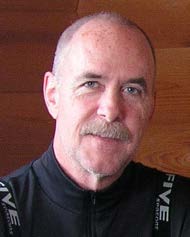From the Editor - May 2016
|
I think it’s ironic, in a sad sort of way, that one of the main aspects of the vocation of geoscience that attracted most of us to it in the first place was the opportunity to spend time outdoors in the field: traipsing around the countryside, contemplating and analyzing outcrops from afar and up close, measuring and describing sections, mapping, collecting samples, deploying geophysical instruments, etc.—and at the same time reveling in beautiful landscapes, daytime “sky-scapes,” the wondrous nighttime canopy of a gazillion stars, and experiencing the ineffable, profound peace (or at times violent but beautiful chaos) of the precious part of God’s creation far from the city. Of course, being in the field at times also entails discomfort, frustrations, bug bites and perhaps other negative things. After all, it’s a part of life. But as geoscientists we greatly treasure our field experiences. |
I say “ironic” and “sad” because so few of us geoscientists, at least in the modern day oil & gas industry, ever get out to the field anymore, at least for our companies’ business. And if we do, it’s typically not to perform traditional field work but rather to participate in brief field seminars. Why did this happen? I’ll suggest a couple of reasons. Time in the field has long been perceived by many non-geoscientist managers (and unfortunately, a few geoscientist managers too) as being frivolous and unproductive, contrived only for fun—i.e. “boondoggles.” Moreover, the geologist who’s doing field work is out of the office, out of sight of management, and therefore more difficult to monitor and control. While the latter may be true, the value of getting out in the field to study outcrops relevant to subsurface work in the same basin, or an analogous basin, is unassailable. And what’s wrong if a part of one’s job happens to be fun?!
If the main focus of the science of geology is the Earth, it logically follows that the primary approach to studying the Earth would be to observe it directly and gather data to analyze and interpret. And the only way to directly observe mesoscale features of the Earth is by getting out into the field. See page 5, where HGS Director Annie Walker makes her own concise, eloquent case for the value of field work.
It’s rare, but in recent years there still have been some larger oil & gas firms that have allowed, and even encouraged field work. One of the things I’ve admired about Mexico’s state oil company Pemex is that they required, up until a few years ago, that each new-hire geologist spend the first couple of years of his/her career doing field mapping as part of a team. These brigadas were typically led by senior-level geologists in Pemex, who used the program to pass on their years of accumulated knowledge to the next generation. In addition, through shared adventures in the brigadas, a strong sense of camaraderie was created which in many cases carried on through entire careers in the company.
There’s an iconic quote in geology that’s worth remembering: Herbert Harold Read (British geologist and Professor of Geology at Imperial College London in 1947-1948, and one-time President of the Geological Society) once said “The best geologist is he who has seen the most rocks.” Most recently, I saw this quote engraved on a plaque hung prominently on the wall at the head of the main hall of the Geology Department at the University of Yangon in Myanmar when I visited there in the summer of 2014 (see photo on page 11 of the January 2016 issue of the HGS Bulletin), and so was heartened to see that the value of field work is still recognized in some parts of our world.
A final note on this topic—one of the trends in our industry that I’ve observed over the course of my career has been an ever-increasing emphasis on safety. Among other improvements, this has resulted in beneficial new rules and regulations related to company-sponsored field seminars, such as the requirement to wear protective headgear. But sometimes these rules and regulations have at times become overly obsessive: such as the recent experience of one friend, who was instructed to wear a helmet while in the field in a prairie setting, with nary a rock to be found above knee-level. Maybe it was meant to mitigate the risk of a meteor shower…
- I’d like to thank geophysicist Elizabeth Desser
for her contributions to this column.

